Impact of Job Satisfaction and Motivation on Employee Performance
VerifiedAdded on 2020/04/29
|69
|10605
|64
Report
AI Summary
This report investigates the impact of job satisfaction and motivation on employee performance, focusing on companies in Switzerland. It begins with an introduction outlining research aims, objectives, and questions, followed by a literature review that explores theories like Herzberg's Two-Factor Theory and the concepts of motivation and employee satisfaction. The research methodology section details the research design, approach, and data collection strategies. The core of the report presents data analysis, including frequency tables, correlations, and regression analyses. The findings reveal the significance of training and development, as well as financial incentives, in enhancing employee motivation and performance. The report concludes with recommendations for improving employee satisfaction and motivation, ultimately aiming to increase productivity and organizational success. The study emphasizes the importance of employee engagement and its impact on talent management and retention.
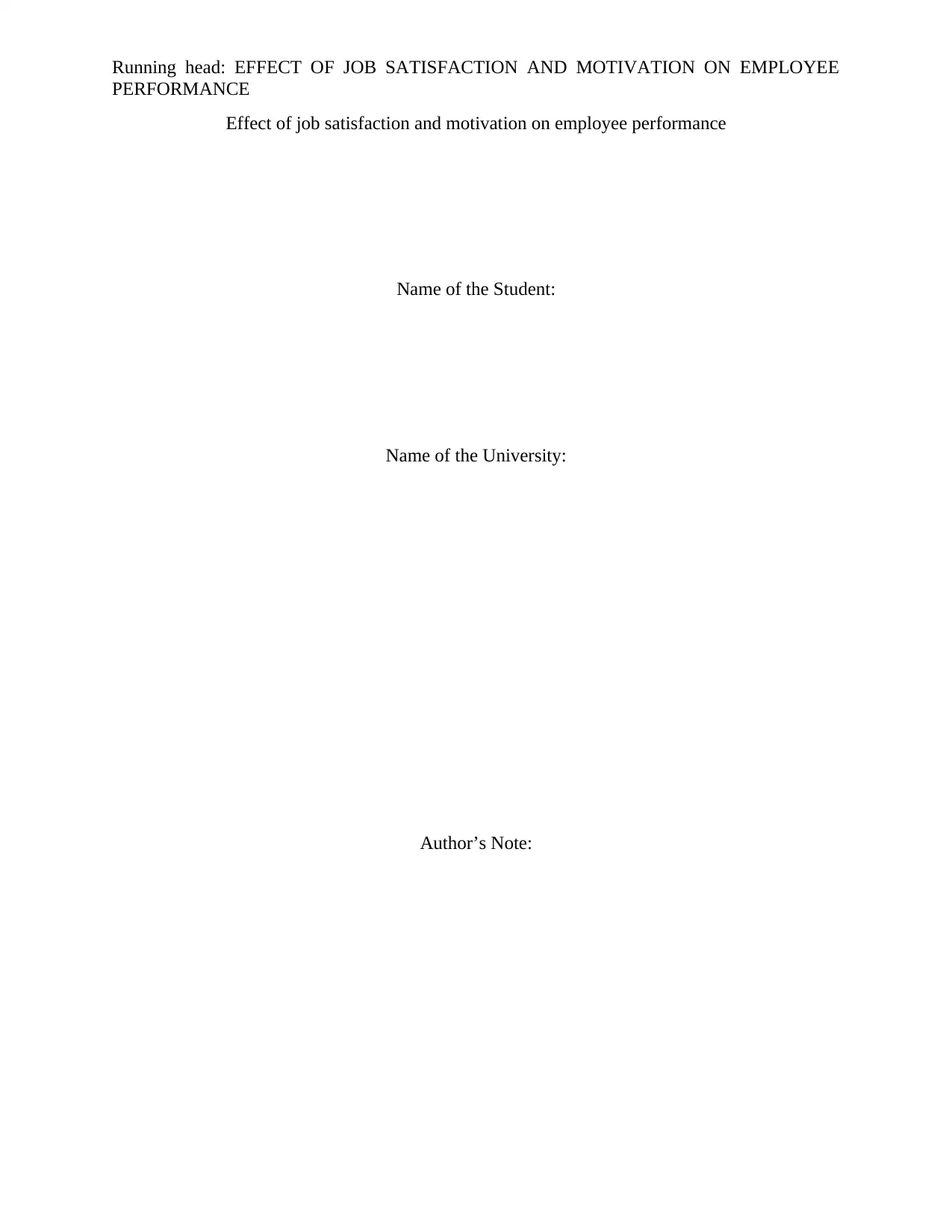
Running head: EFFECT OF JOB SATISFACTION AND MOTIVATION ON EMPLOYEE
PERFORMANCE
Effect of job satisfaction and motivation on employee performance
Name of the Student:
Name of the University:
Author’s Note:
PERFORMANCE
Effect of job satisfaction and motivation on employee performance
Name of the Student:
Name of the University:
Author’s Note:
Paraphrase This Document
Need a fresh take? Get an instant paraphrase of this document with our AI Paraphraser
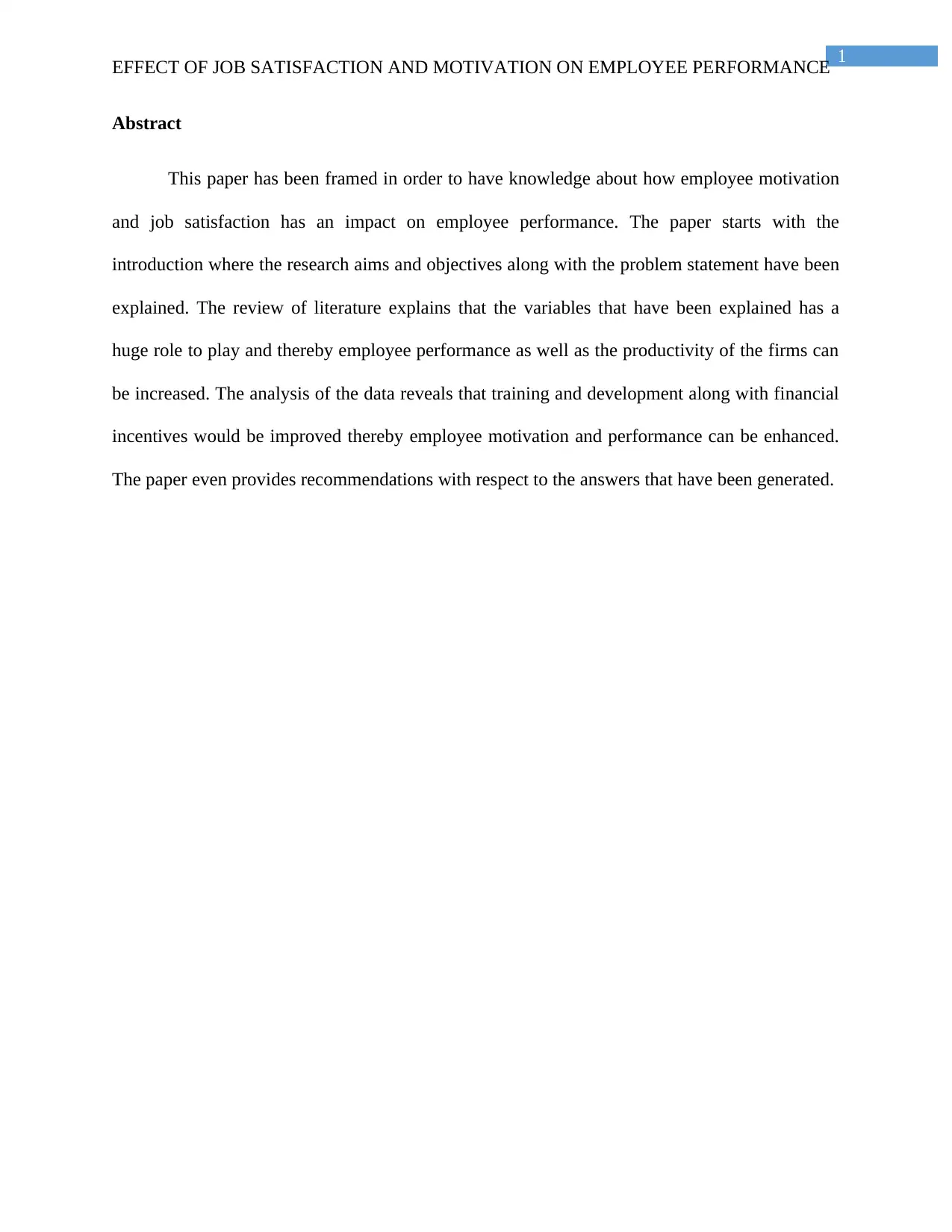
1
EFFECT OF JOB SATISFACTION AND MOTIVATION ON EMPLOYEE PERFORMANCE
Abstract
This paper has been framed in order to have knowledge about how employee motivation
and job satisfaction has an impact on employee performance. The paper starts with the
introduction where the research aims and objectives along with the problem statement have been
explained. The review of literature explains that the variables that have been explained has a
huge role to play and thereby employee performance as well as the productivity of the firms can
be increased. The analysis of the data reveals that training and development along with financial
incentives would be improved thereby employee motivation and performance can be enhanced.
The paper even provides recommendations with respect to the answers that have been generated.
EFFECT OF JOB SATISFACTION AND MOTIVATION ON EMPLOYEE PERFORMANCE
Abstract
This paper has been framed in order to have knowledge about how employee motivation
and job satisfaction has an impact on employee performance. The paper starts with the
introduction where the research aims and objectives along with the problem statement have been
explained. The review of literature explains that the variables that have been explained has a
huge role to play and thereby employee performance as well as the productivity of the firms can
be increased. The analysis of the data reveals that training and development along with financial
incentives would be improved thereby employee motivation and performance can be enhanced.
The paper even provides recommendations with respect to the answers that have been generated.
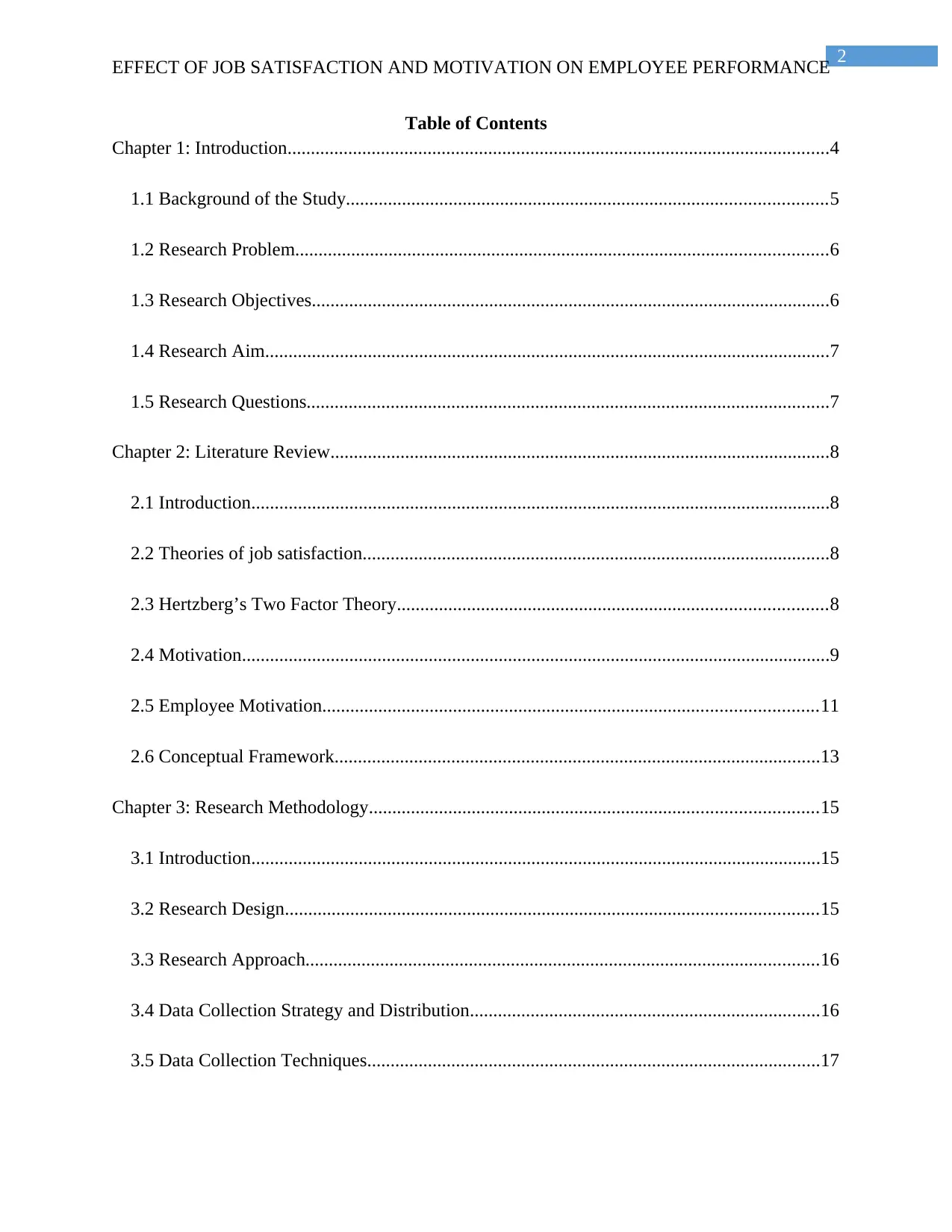
2
EFFECT OF JOB SATISFACTION AND MOTIVATION ON EMPLOYEE PERFORMANCE
Table of Contents
Chapter 1: Introduction....................................................................................................................4
1.1 Background of the Study.......................................................................................................5
1.2 Research Problem..................................................................................................................6
1.3 Research Objectives...............................................................................................................6
1.4 Research Aim.........................................................................................................................7
1.5 Research Questions................................................................................................................7
Chapter 2: Literature Review...........................................................................................................8
2.1 Introduction............................................................................................................................8
2.2 Theories of job satisfaction....................................................................................................8
2.3 Hertzberg’s Two Factor Theory............................................................................................8
2.4 Motivation..............................................................................................................................9
2.5 Employee Motivation..........................................................................................................11
2.6 Conceptual Framework........................................................................................................13
Chapter 3: Research Methodology................................................................................................15
3.1 Introduction..........................................................................................................................15
3.2 Research Design..................................................................................................................15
3.3 Research Approach..............................................................................................................16
3.4 Data Collection Strategy and Distribution...........................................................................16
3.5 Data Collection Techniques.................................................................................................17
EFFECT OF JOB SATISFACTION AND MOTIVATION ON EMPLOYEE PERFORMANCE
Table of Contents
Chapter 1: Introduction....................................................................................................................4
1.1 Background of the Study.......................................................................................................5
1.2 Research Problem..................................................................................................................6
1.3 Research Objectives...............................................................................................................6
1.4 Research Aim.........................................................................................................................7
1.5 Research Questions................................................................................................................7
Chapter 2: Literature Review...........................................................................................................8
2.1 Introduction............................................................................................................................8
2.2 Theories of job satisfaction....................................................................................................8
2.3 Hertzberg’s Two Factor Theory............................................................................................8
2.4 Motivation..............................................................................................................................9
2.5 Employee Motivation..........................................................................................................11
2.6 Conceptual Framework........................................................................................................13
Chapter 3: Research Methodology................................................................................................15
3.1 Introduction..........................................................................................................................15
3.2 Research Design..................................................................................................................15
3.3 Research Approach..............................................................................................................16
3.4 Data Collection Strategy and Distribution...........................................................................16
3.5 Data Collection Techniques.................................................................................................17
⊘ This is a preview!⊘
Do you want full access?
Subscribe today to unlock all pages.

Trusted by 1+ million students worldwide
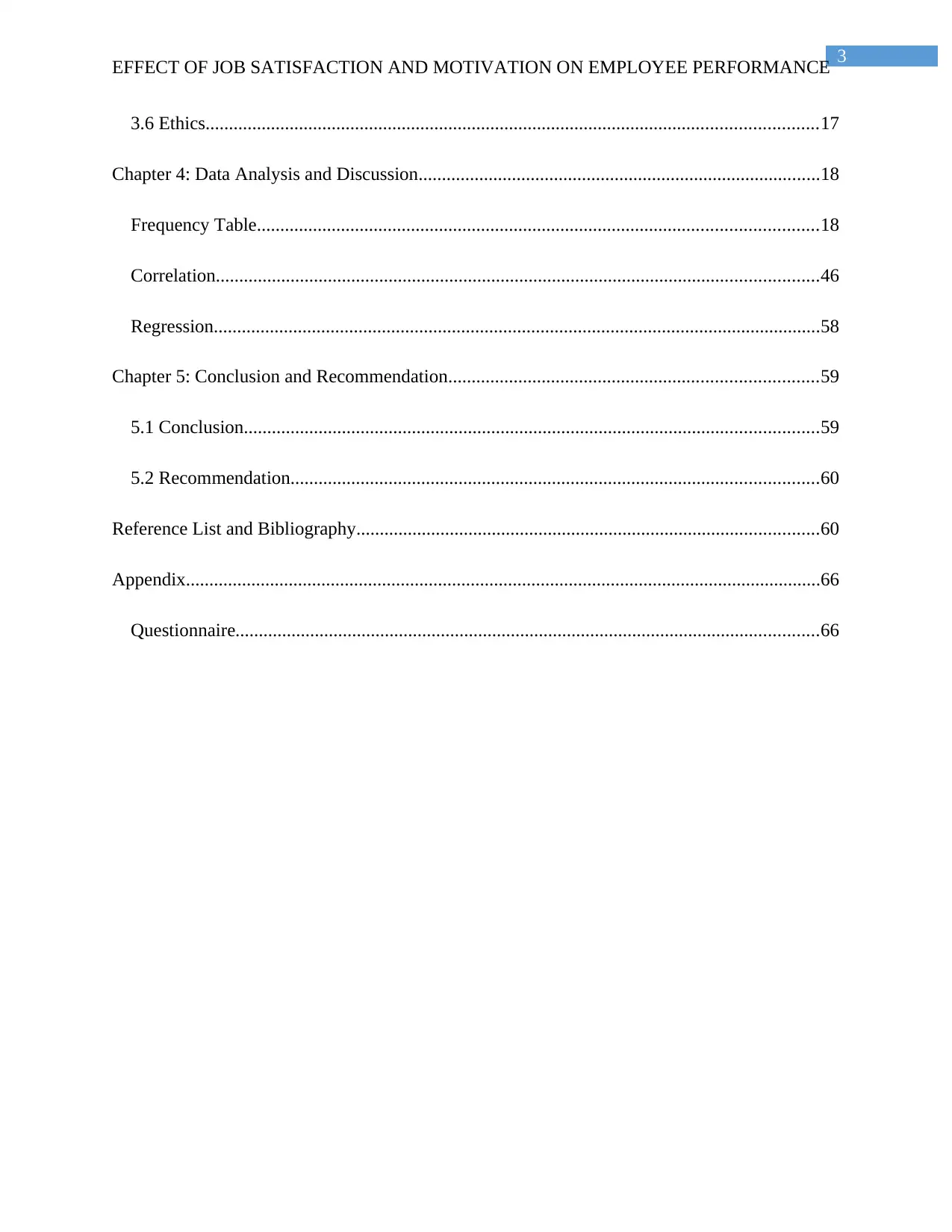
3
EFFECT OF JOB SATISFACTION AND MOTIVATION ON EMPLOYEE PERFORMANCE
3.6 Ethics...................................................................................................................................17
Chapter 4: Data Analysis and Discussion......................................................................................18
Frequency Table........................................................................................................................18
Correlation.................................................................................................................................46
Regression..................................................................................................................................58
Chapter 5: Conclusion and Recommendation...............................................................................59
5.1 Conclusion...........................................................................................................................59
5.2 Recommendation.................................................................................................................60
Reference List and Bibliography...................................................................................................60
Appendix........................................................................................................................................66
Questionnaire.............................................................................................................................66
EFFECT OF JOB SATISFACTION AND MOTIVATION ON EMPLOYEE PERFORMANCE
3.6 Ethics...................................................................................................................................17
Chapter 4: Data Analysis and Discussion......................................................................................18
Frequency Table........................................................................................................................18
Correlation.................................................................................................................................46
Regression..................................................................................................................................58
Chapter 5: Conclusion and Recommendation...............................................................................59
5.1 Conclusion...........................................................................................................................59
5.2 Recommendation.................................................................................................................60
Reference List and Bibliography...................................................................................................60
Appendix........................................................................................................................................66
Questionnaire.............................................................................................................................66
Paraphrase This Document
Need a fresh take? Get an instant paraphrase of this document with our AI Paraphraser
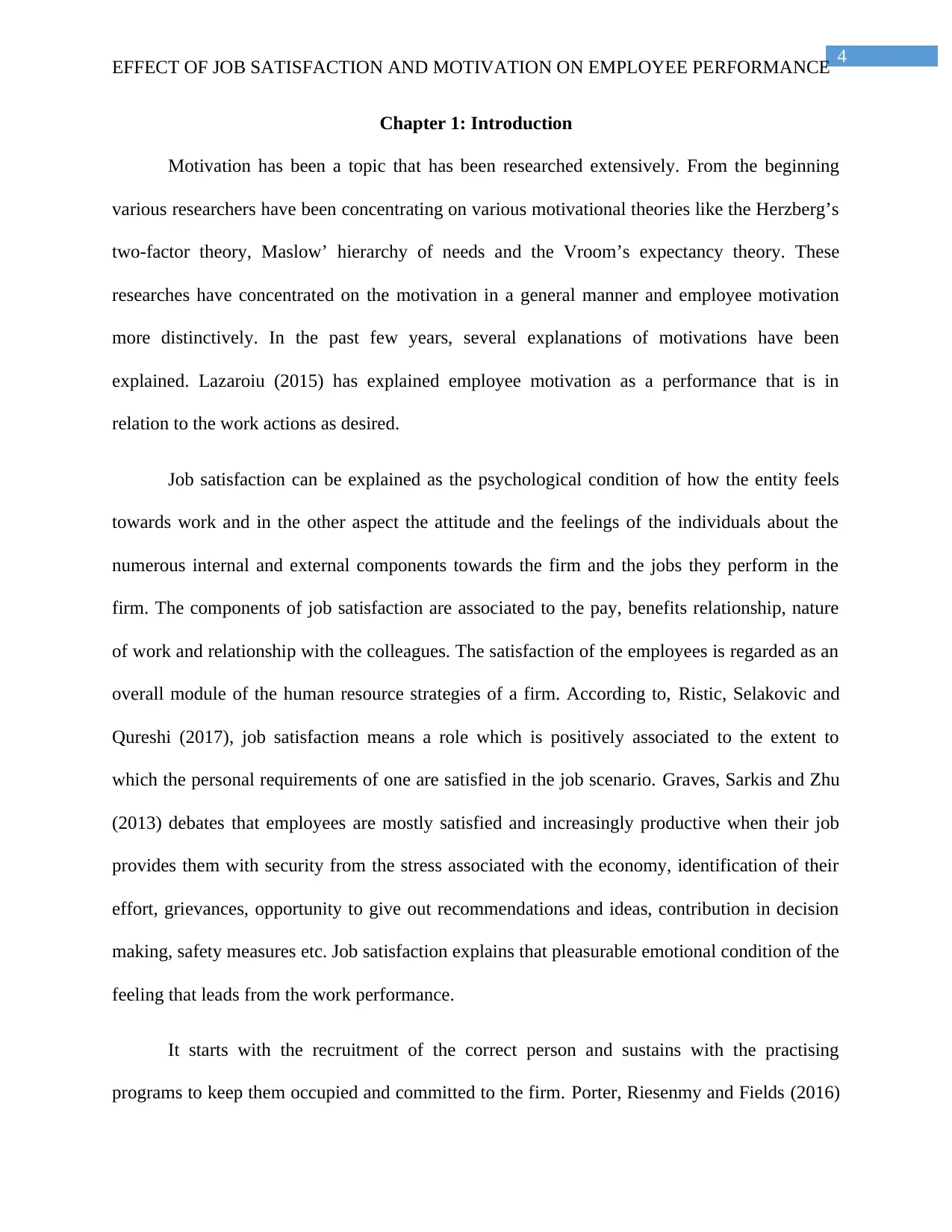
4
EFFECT OF JOB SATISFACTION AND MOTIVATION ON EMPLOYEE PERFORMANCE
Chapter 1: Introduction
Motivation has been a topic that has been researched extensively. From the beginning
various researchers have been concentrating on various motivational theories like the Herzberg’s
two-factor theory, Maslow’ hierarchy of needs and the Vroom’s expectancy theory. These
researches have concentrated on the motivation in a general manner and employee motivation
more distinctively. In the past few years, several explanations of motivations have been
explained. Lazaroiu (2015) has explained employee motivation as a performance that is in
relation to the work actions as desired.
Job satisfaction can be explained as the psychological condition of how the entity feels
towards work and in the other aspect the attitude and the feelings of the individuals about the
numerous internal and external components towards the firm and the jobs they perform in the
firm. The components of job satisfaction are associated to the pay, benefits relationship, nature
of work and relationship with the colleagues. The satisfaction of the employees is regarded as an
overall module of the human resource strategies of a firm. According to, Ristic, Selakovic and
Qureshi (2017), job satisfaction means a role which is positively associated to the extent to
which the personal requirements of one are satisfied in the job scenario. Graves, Sarkis and Zhu
(2013) debates that employees are mostly satisfied and increasingly productive when their job
provides them with security from the stress associated with the economy, identification of their
effort, grievances, opportunity to give out recommendations and ideas, contribution in decision
making, safety measures etc. Job satisfaction explains that pleasurable emotional condition of the
feeling that leads from the work performance.
It starts with the recruitment of the correct person and sustains with the practising
programs to keep them occupied and committed to the firm. Porter, Riesenmy and Fields (2016)
EFFECT OF JOB SATISFACTION AND MOTIVATION ON EMPLOYEE PERFORMANCE
Chapter 1: Introduction
Motivation has been a topic that has been researched extensively. From the beginning
various researchers have been concentrating on various motivational theories like the Herzberg’s
two-factor theory, Maslow’ hierarchy of needs and the Vroom’s expectancy theory. These
researches have concentrated on the motivation in a general manner and employee motivation
more distinctively. In the past few years, several explanations of motivations have been
explained. Lazaroiu (2015) has explained employee motivation as a performance that is in
relation to the work actions as desired.
Job satisfaction can be explained as the psychological condition of how the entity feels
towards work and in the other aspect the attitude and the feelings of the individuals about the
numerous internal and external components towards the firm and the jobs they perform in the
firm. The components of job satisfaction are associated to the pay, benefits relationship, nature
of work and relationship with the colleagues. The satisfaction of the employees is regarded as an
overall module of the human resource strategies of a firm. According to, Ristic, Selakovic and
Qureshi (2017), job satisfaction means a role which is positively associated to the extent to
which the personal requirements of one are satisfied in the job scenario. Graves, Sarkis and Zhu
(2013) debates that employees are mostly satisfied and increasingly productive when their job
provides them with security from the stress associated with the economy, identification of their
effort, grievances, opportunity to give out recommendations and ideas, contribution in decision
making, safety measures etc. Job satisfaction explains that pleasurable emotional condition of the
feeling that leads from the work performance.
It starts with the recruitment of the correct person and sustains with the practising
programs to keep them occupied and committed to the firm. Porter, Riesenmy and Fields (2016)
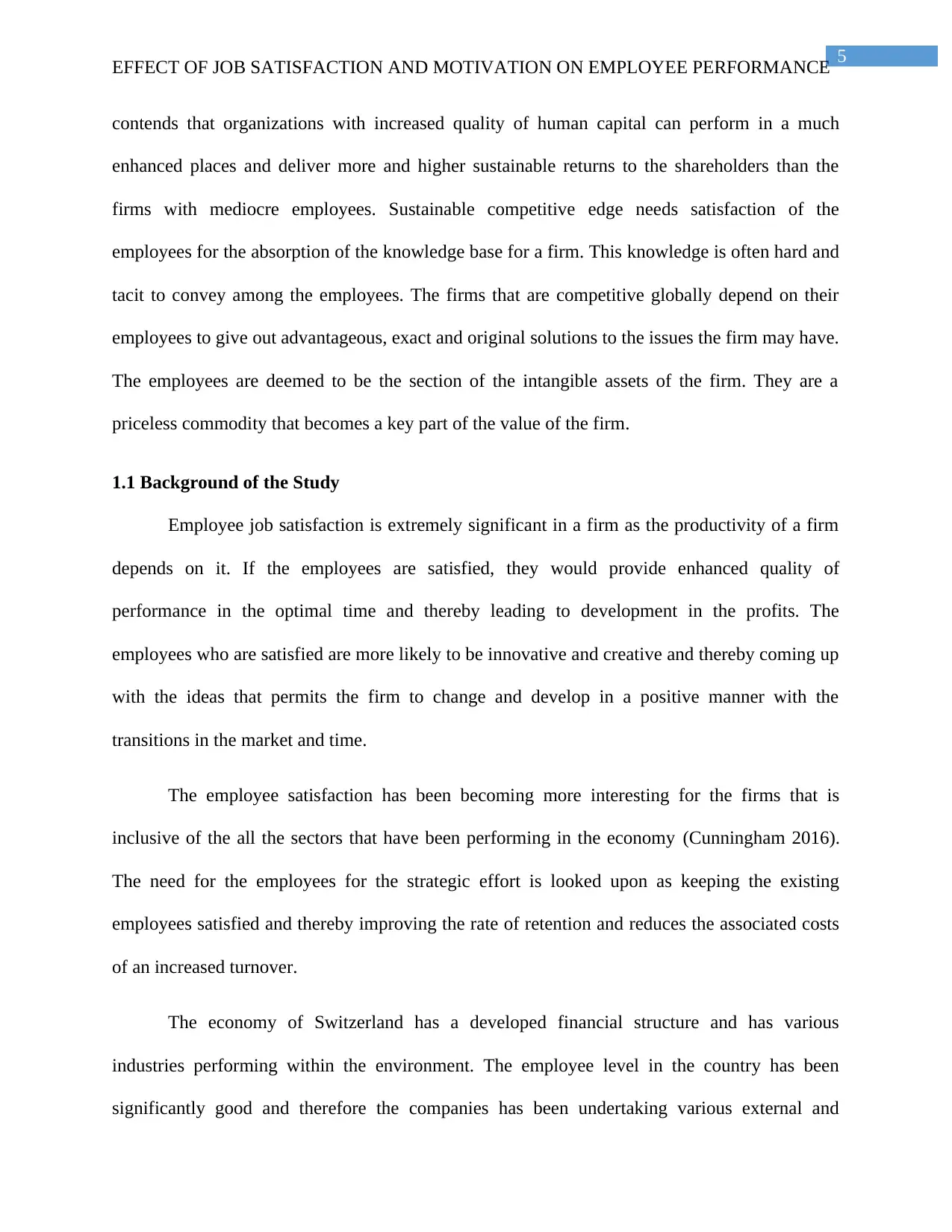
5
EFFECT OF JOB SATISFACTION AND MOTIVATION ON EMPLOYEE PERFORMANCE
contends that organizations with increased quality of human capital can perform in a much
enhanced places and deliver more and higher sustainable returns to the shareholders than the
firms with mediocre employees. Sustainable competitive edge needs satisfaction of the
employees for the absorption of the knowledge base for a firm. This knowledge is often hard and
tacit to convey among the employees. The firms that are competitive globally depend on their
employees to give out advantageous, exact and original solutions to the issues the firm may have.
The employees are deemed to be the section of the intangible assets of the firm. They are a
priceless commodity that becomes a key part of the value of the firm.
1.1 Background of the Study
Employee job satisfaction is extremely significant in a firm as the productivity of a firm
depends on it. If the employees are satisfied, they would provide enhanced quality of
performance in the optimal time and thereby leading to development in the profits. The
employees who are satisfied are more likely to be innovative and creative and thereby coming up
with the ideas that permits the firm to change and develop in a positive manner with the
transitions in the market and time.
The employee satisfaction has been becoming more interesting for the firms that is
inclusive of the all the sectors that have been performing in the economy (Cunningham 2016).
The need for the employees for the strategic effort is looked upon as keeping the existing
employees satisfied and thereby improving the rate of retention and reduces the associated costs
of an increased turnover.
The economy of Switzerland has a developed financial structure and has various
industries performing within the environment. The employee level in the country has been
significantly good and therefore the companies has been undertaking various external and
EFFECT OF JOB SATISFACTION AND MOTIVATION ON EMPLOYEE PERFORMANCE
contends that organizations with increased quality of human capital can perform in a much
enhanced places and deliver more and higher sustainable returns to the shareholders than the
firms with mediocre employees. Sustainable competitive edge needs satisfaction of the
employees for the absorption of the knowledge base for a firm. This knowledge is often hard and
tacit to convey among the employees. The firms that are competitive globally depend on their
employees to give out advantageous, exact and original solutions to the issues the firm may have.
The employees are deemed to be the section of the intangible assets of the firm. They are a
priceless commodity that becomes a key part of the value of the firm.
1.1 Background of the Study
Employee job satisfaction is extremely significant in a firm as the productivity of a firm
depends on it. If the employees are satisfied, they would provide enhanced quality of
performance in the optimal time and thereby leading to development in the profits. The
employees who are satisfied are more likely to be innovative and creative and thereby coming up
with the ideas that permits the firm to change and develop in a positive manner with the
transitions in the market and time.
The employee satisfaction has been becoming more interesting for the firms that is
inclusive of the all the sectors that have been performing in the economy (Cunningham 2016).
The need for the employees for the strategic effort is looked upon as keeping the existing
employees satisfied and thereby improving the rate of retention and reduces the associated costs
of an increased turnover.
The economy of Switzerland has a developed financial structure and has various
industries performing within the environment. The employee level in the country has been
significantly good and therefore the companies has been undertaking various external and
⊘ This is a preview!⊘
Do you want full access?
Subscribe today to unlock all pages.

Trusted by 1+ million students worldwide
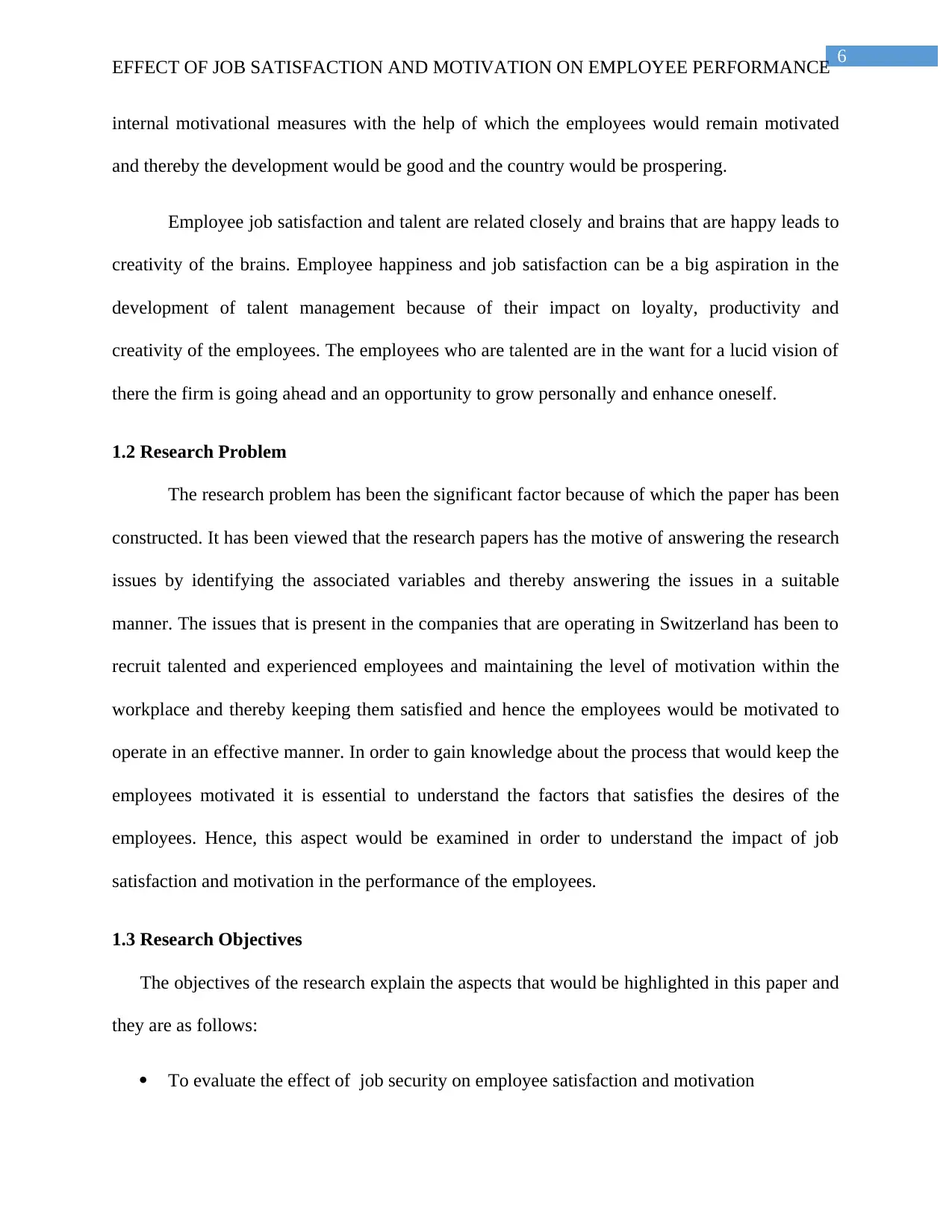
6
EFFECT OF JOB SATISFACTION AND MOTIVATION ON EMPLOYEE PERFORMANCE
internal motivational measures with the help of which the employees would remain motivated
and thereby the development would be good and the country would be prospering.
Employee job satisfaction and talent are related closely and brains that are happy leads to
creativity of the brains. Employee happiness and job satisfaction can be a big aspiration in the
development of talent management because of their impact on loyalty, productivity and
creativity of the employees. The employees who are talented are in the want for a lucid vision of
there the firm is going ahead and an opportunity to grow personally and enhance oneself.
1.2 Research Problem
The research problem has been the significant factor because of which the paper has been
constructed. It has been viewed that the research papers has the motive of answering the research
issues by identifying the associated variables and thereby answering the issues in a suitable
manner. The issues that is present in the companies that are operating in Switzerland has been to
recruit talented and experienced employees and maintaining the level of motivation within the
workplace and thereby keeping them satisfied and hence the employees would be motivated to
operate in an effective manner. In order to gain knowledge about the process that would keep the
employees motivated it is essential to understand the factors that satisfies the desires of the
employees. Hence, this aspect would be examined in order to understand the impact of job
satisfaction and motivation in the performance of the employees.
1.3 Research Objectives
The objectives of the research explain the aspects that would be highlighted in this paper and
they are as follows:
To evaluate the effect of job security on employee satisfaction and motivation
EFFECT OF JOB SATISFACTION AND MOTIVATION ON EMPLOYEE PERFORMANCE
internal motivational measures with the help of which the employees would remain motivated
and thereby the development would be good and the country would be prospering.
Employee job satisfaction and talent are related closely and brains that are happy leads to
creativity of the brains. Employee happiness and job satisfaction can be a big aspiration in the
development of talent management because of their impact on loyalty, productivity and
creativity of the employees. The employees who are talented are in the want for a lucid vision of
there the firm is going ahead and an opportunity to grow personally and enhance oneself.
1.2 Research Problem
The research problem has been the significant factor because of which the paper has been
constructed. It has been viewed that the research papers has the motive of answering the research
issues by identifying the associated variables and thereby answering the issues in a suitable
manner. The issues that is present in the companies that are operating in Switzerland has been to
recruit talented and experienced employees and maintaining the level of motivation within the
workplace and thereby keeping them satisfied and hence the employees would be motivated to
operate in an effective manner. In order to gain knowledge about the process that would keep the
employees motivated it is essential to understand the factors that satisfies the desires of the
employees. Hence, this aspect would be examined in order to understand the impact of job
satisfaction and motivation in the performance of the employees.
1.3 Research Objectives
The objectives of the research explain the aspects that would be highlighted in this paper and
they are as follows:
To evaluate the effect of job security on employee satisfaction and motivation
Paraphrase This Document
Need a fresh take? Get an instant paraphrase of this document with our AI Paraphraser
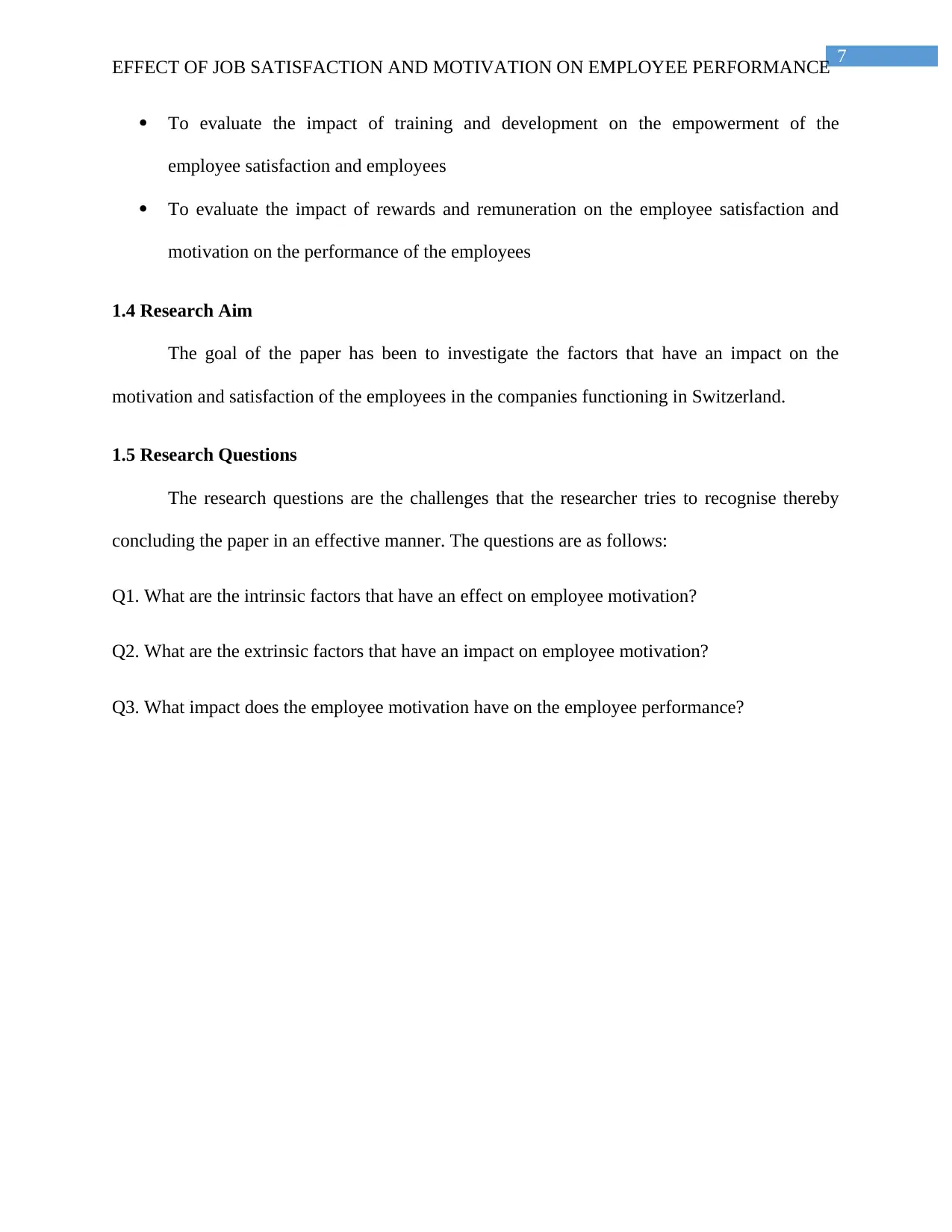
7
EFFECT OF JOB SATISFACTION AND MOTIVATION ON EMPLOYEE PERFORMANCE
To evaluate the impact of training and development on the empowerment of the
employee satisfaction and employees
To evaluate the impact of rewards and remuneration on the employee satisfaction and
motivation on the performance of the employees
1.4 Research Aim
The goal of the paper has been to investigate the factors that have an impact on the
motivation and satisfaction of the employees in the companies functioning in Switzerland.
1.5 Research Questions
The research questions are the challenges that the researcher tries to recognise thereby
concluding the paper in an effective manner. The questions are as follows:
Q1. What are the intrinsic factors that have an effect on employee motivation?
Q2. What are the extrinsic factors that have an impact on employee motivation?
Q3. What impact does the employee motivation have on the employee performance?
EFFECT OF JOB SATISFACTION AND MOTIVATION ON EMPLOYEE PERFORMANCE
To evaluate the impact of training and development on the empowerment of the
employee satisfaction and employees
To evaluate the impact of rewards and remuneration on the employee satisfaction and
motivation on the performance of the employees
1.4 Research Aim
The goal of the paper has been to investigate the factors that have an impact on the
motivation and satisfaction of the employees in the companies functioning in Switzerland.
1.5 Research Questions
The research questions are the challenges that the researcher tries to recognise thereby
concluding the paper in an effective manner. The questions are as follows:
Q1. What are the intrinsic factors that have an effect on employee motivation?
Q2. What are the extrinsic factors that have an impact on employee motivation?
Q3. What impact does the employee motivation have on the employee performance?
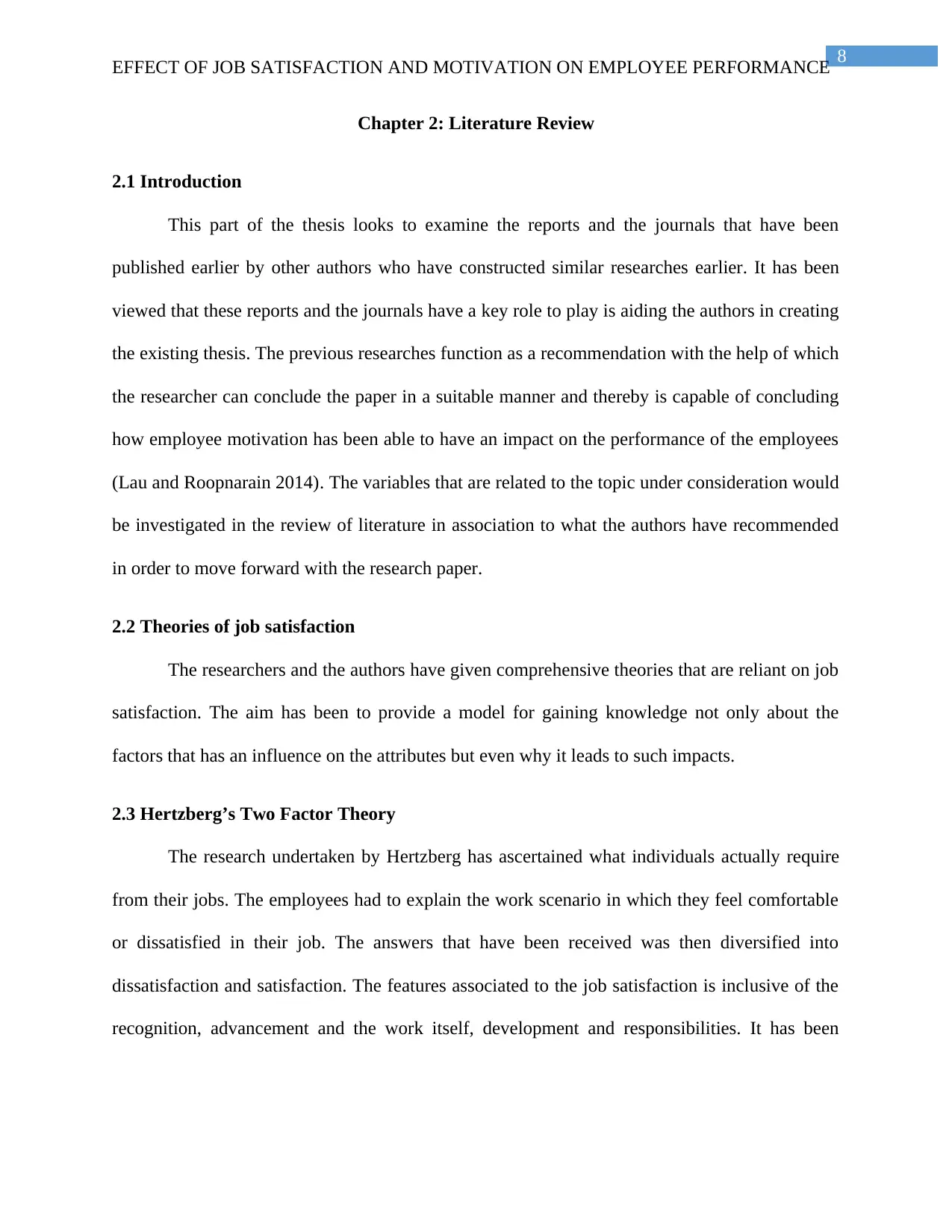
8
EFFECT OF JOB SATISFACTION AND MOTIVATION ON EMPLOYEE PERFORMANCE
Chapter 2: Literature Review
2.1 Introduction
This part of the thesis looks to examine the reports and the journals that have been
published earlier by other authors who have constructed similar researches earlier. It has been
viewed that these reports and the journals have a key role to play is aiding the authors in creating
the existing thesis. The previous researches function as a recommendation with the help of which
the researcher can conclude the paper in a suitable manner and thereby is capable of concluding
how employee motivation has been able to have an impact on the performance of the employees
(Lau and Roopnarain 2014). The variables that are related to the topic under consideration would
be investigated in the review of literature in association to what the authors have recommended
in order to move forward with the research paper.
2.2 Theories of job satisfaction
The researchers and the authors have given comprehensive theories that are reliant on job
satisfaction. The aim has been to provide a model for gaining knowledge not only about the
factors that has an influence on the attributes but even why it leads to such impacts.
2.3 Hertzberg’s Two Factor Theory
The research undertaken by Hertzberg has ascertained what individuals actually require
from their jobs. The employees had to explain the work scenario in which they feel comfortable
or dissatisfied in their job. The answers that have been received was then diversified into
dissatisfaction and satisfaction. The features associated to the job satisfaction is inclusive of the
recognition, advancement and the work itself, development and responsibilities. It has been
EFFECT OF JOB SATISFACTION AND MOTIVATION ON EMPLOYEE PERFORMANCE
Chapter 2: Literature Review
2.1 Introduction
This part of the thesis looks to examine the reports and the journals that have been
published earlier by other authors who have constructed similar researches earlier. It has been
viewed that these reports and the journals have a key role to play is aiding the authors in creating
the existing thesis. The previous researches function as a recommendation with the help of which
the researcher can conclude the paper in a suitable manner and thereby is capable of concluding
how employee motivation has been able to have an impact on the performance of the employees
(Lau and Roopnarain 2014). The variables that are related to the topic under consideration would
be investigated in the review of literature in association to what the authors have recommended
in order to move forward with the research paper.
2.2 Theories of job satisfaction
The researchers and the authors have given comprehensive theories that are reliant on job
satisfaction. The aim has been to provide a model for gaining knowledge not only about the
factors that has an influence on the attributes but even why it leads to such impacts.
2.3 Hertzberg’s Two Factor Theory
The research undertaken by Hertzberg has ascertained what individuals actually require
from their jobs. The employees had to explain the work scenario in which they feel comfortable
or dissatisfied in their job. The answers that have been received was then diversified into
dissatisfaction and satisfaction. The features associated to the job satisfaction is inclusive of the
recognition, advancement and the work itself, development and responsibilities. It has been
⊘ This is a preview!⊘
Do you want full access?
Subscribe today to unlock all pages.

Trusted by 1+ million students worldwide
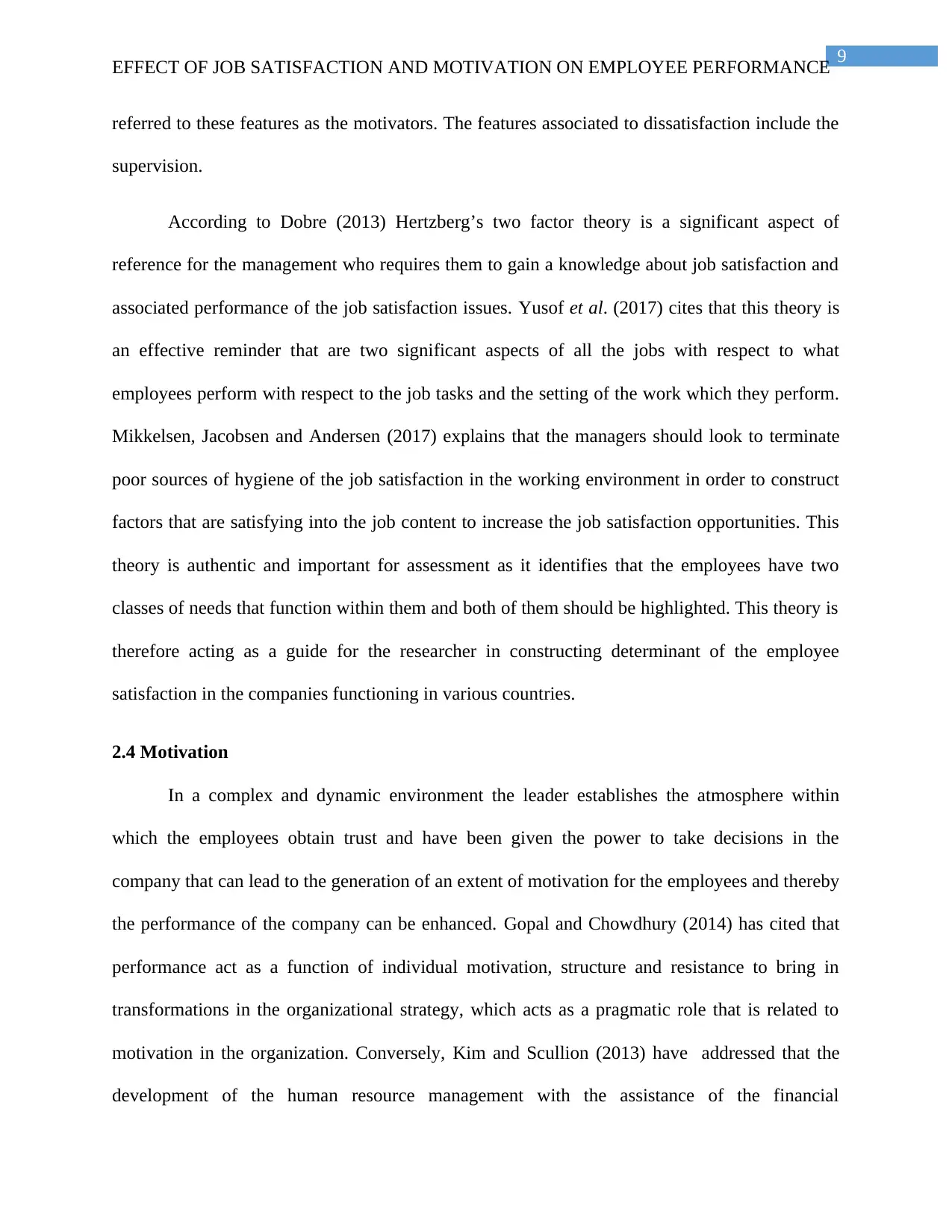
9
EFFECT OF JOB SATISFACTION AND MOTIVATION ON EMPLOYEE PERFORMANCE
referred to these features as the motivators. The features associated to dissatisfaction include the
supervision.
According to Dobre (2013) Hertzberg’s two factor theory is a significant aspect of
reference for the management who requires them to gain a knowledge about job satisfaction and
associated performance of the job satisfaction issues. Yusof et al. (2017) cites that this theory is
an effective reminder that are two significant aspects of all the jobs with respect to what
employees perform with respect to the job tasks and the setting of the work which they perform.
Mikkelsen, Jacobsen and Andersen (2017) explains that the managers should look to terminate
poor sources of hygiene of the job satisfaction in the working environment in order to construct
factors that are satisfying into the job content to increase the job satisfaction opportunities. This
theory is authentic and important for assessment as it identifies that the employees have two
classes of needs that function within them and both of them should be highlighted. This theory is
therefore acting as a guide for the researcher in constructing determinant of the employee
satisfaction in the companies functioning in various countries.
2.4 Motivation
In a complex and dynamic environment the leader establishes the atmosphere within
which the employees obtain trust and have been given the power to take decisions in the
company that can lead to the generation of an extent of motivation for the employees and thereby
the performance of the company can be enhanced. Gopal and Chowdhury (2014) has cited that
performance act as a function of individual motivation, structure and resistance to bring in
transformations in the organizational strategy, which acts as a pragmatic role that is related to
motivation in the organization. Conversely, Kim and Scullion (2013) have addressed that the
development of the human resource management with the assistance of the financial
EFFECT OF JOB SATISFACTION AND MOTIVATION ON EMPLOYEE PERFORMANCE
referred to these features as the motivators. The features associated to dissatisfaction include the
supervision.
According to Dobre (2013) Hertzberg’s two factor theory is a significant aspect of
reference for the management who requires them to gain a knowledge about job satisfaction and
associated performance of the job satisfaction issues. Yusof et al. (2017) cites that this theory is
an effective reminder that are two significant aspects of all the jobs with respect to what
employees perform with respect to the job tasks and the setting of the work which they perform.
Mikkelsen, Jacobsen and Andersen (2017) explains that the managers should look to terminate
poor sources of hygiene of the job satisfaction in the working environment in order to construct
factors that are satisfying into the job content to increase the job satisfaction opportunities. This
theory is authentic and important for assessment as it identifies that the employees have two
classes of needs that function within them and both of them should be highlighted. This theory is
therefore acting as a guide for the researcher in constructing determinant of the employee
satisfaction in the companies functioning in various countries.
2.4 Motivation
In a complex and dynamic environment the leader establishes the atmosphere within
which the employees obtain trust and have been given the power to take decisions in the
company that can lead to the generation of an extent of motivation for the employees and thereby
the performance of the company can be enhanced. Gopal and Chowdhury (2014) has cited that
performance act as a function of individual motivation, structure and resistance to bring in
transformations in the organizational strategy, which acts as a pragmatic role that is related to
motivation in the organization. Conversely, Kim and Scullion (2013) have addressed that the
development of the human resource management with the assistance of the financial
Paraphrase This Document
Need a fresh take? Get an instant paraphrase of this document with our AI Paraphraser
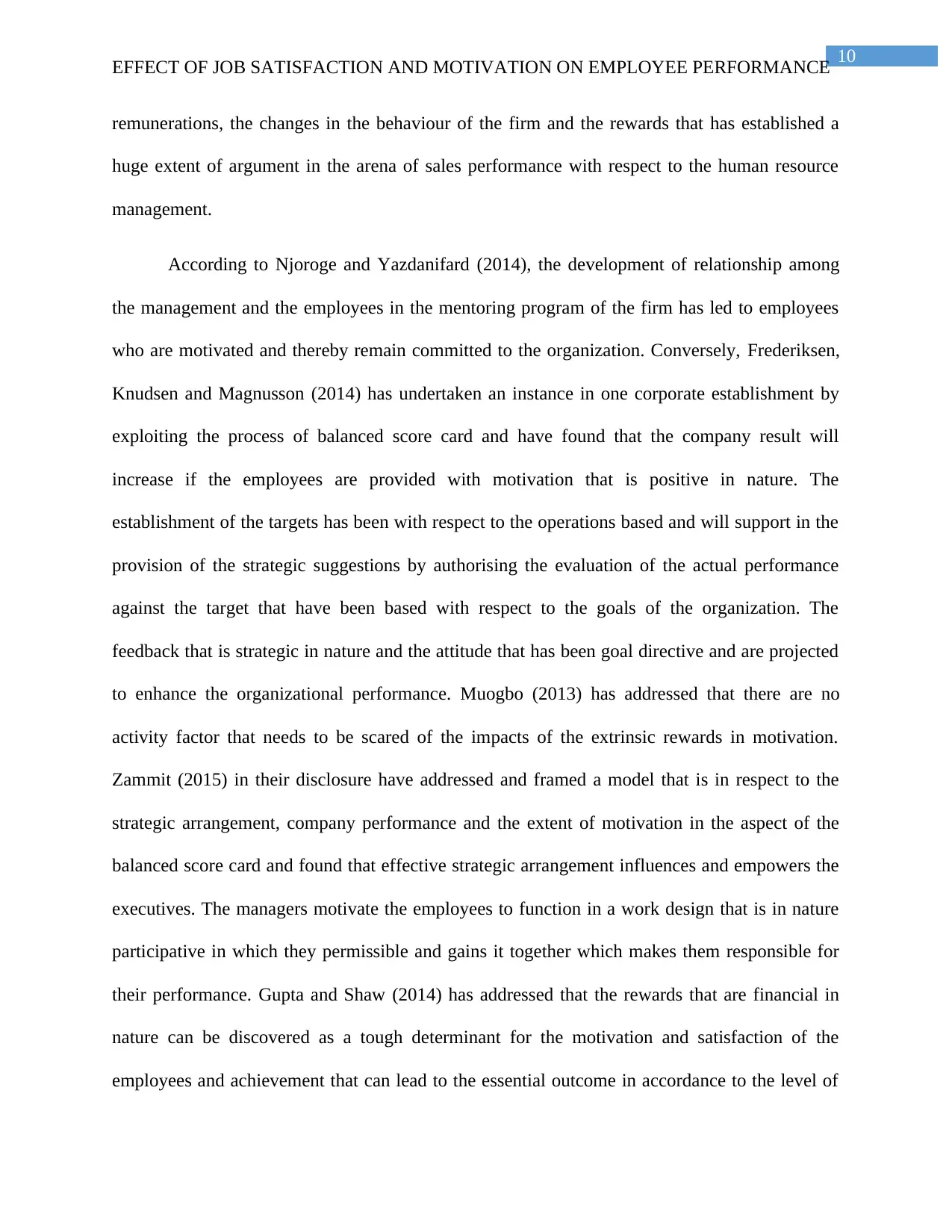
10
EFFECT OF JOB SATISFACTION AND MOTIVATION ON EMPLOYEE PERFORMANCE
remunerations, the changes in the behaviour of the firm and the rewards that has established a
huge extent of argument in the arena of sales performance with respect to the human resource
management.
According to Njoroge and Yazdanifard (2014), the development of relationship among
the management and the employees in the mentoring program of the firm has led to employees
who are motivated and thereby remain committed to the organization. Conversely, Frederiksen,
Knudsen and Magnusson (2014) has undertaken an instance in one corporate establishment by
exploiting the process of balanced score card and have found that the company result will
increase if the employees are provided with motivation that is positive in nature. The
establishment of the targets has been with respect to the operations based and will support in the
provision of the strategic suggestions by authorising the evaluation of the actual performance
against the target that have been based with respect to the goals of the organization. The
feedback that is strategic in nature and the attitude that has been goal directive and are projected
to enhance the organizational performance. Muogbo (2013) has addressed that there are no
activity factor that needs to be scared of the impacts of the extrinsic rewards in motivation.
Zammit (2015) in their disclosure have addressed and framed a model that is in respect to the
strategic arrangement, company performance and the extent of motivation in the aspect of the
balanced score card and found that effective strategic arrangement influences and empowers the
executives. The managers motivate the employees to function in a work design that is in nature
participative in which they permissible and gains it together which makes them responsible for
their performance. Gupta and Shaw (2014) has addressed that the rewards that are financial in
nature can be discovered as a tough determinant for the motivation and satisfaction of the
employees and achievement that can lead to the essential outcome in accordance to the level of
EFFECT OF JOB SATISFACTION AND MOTIVATION ON EMPLOYEE PERFORMANCE
remunerations, the changes in the behaviour of the firm and the rewards that has established a
huge extent of argument in the arena of sales performance with respect to the human resource
management.
According to Njoroge and Yazdanifard (2014), the development of relationship among
the management and the employees in the mentoring program of the firm has led to employees
who are motivated and thereby remain committed to the organization. Conversely, Frederiksen,
Knudsen and Magnusson (2014) has undertaken an instance in one corporate establishment by
exploiting the process of balanced score card and have found that the company result will
increase if the employees are provided with motivation that is positive in nature. The
establishment of the targets has been with respect to the operations based and will support in the
provision of the strategic suggestions by authorising the evaluation of the actual performance
against the target that have been based with respect to the goals of the organization. The
feedback that is strategic in nature and the attitude that has been goal directive and are projected
to enhance the organizational performance. Muogbo (2013) has addressed that there are no
activity factor that needs to be scared of the impacts of the extrinsic rewards in motivation.
Zammit (2015) in their disclosure have addressed and framed a model that is in respect to the
strategic arrangement, company performance and the extent of motivation in the aspect of the
balanced score card and found that effective strategic arrangement influences and empowers the
executives. The managers motivate the employees to function in a work design that is in nature
participative in which they permissible and gains it together which makes them responsible for
their performance. Gupta and Shaw (2014) has addressed that the rewards that are financial in
nature can be discovered as a tough determinant for the motivation and satisfaction of the
employees and achievement that can lead to the essential outcome in accordance to the level of
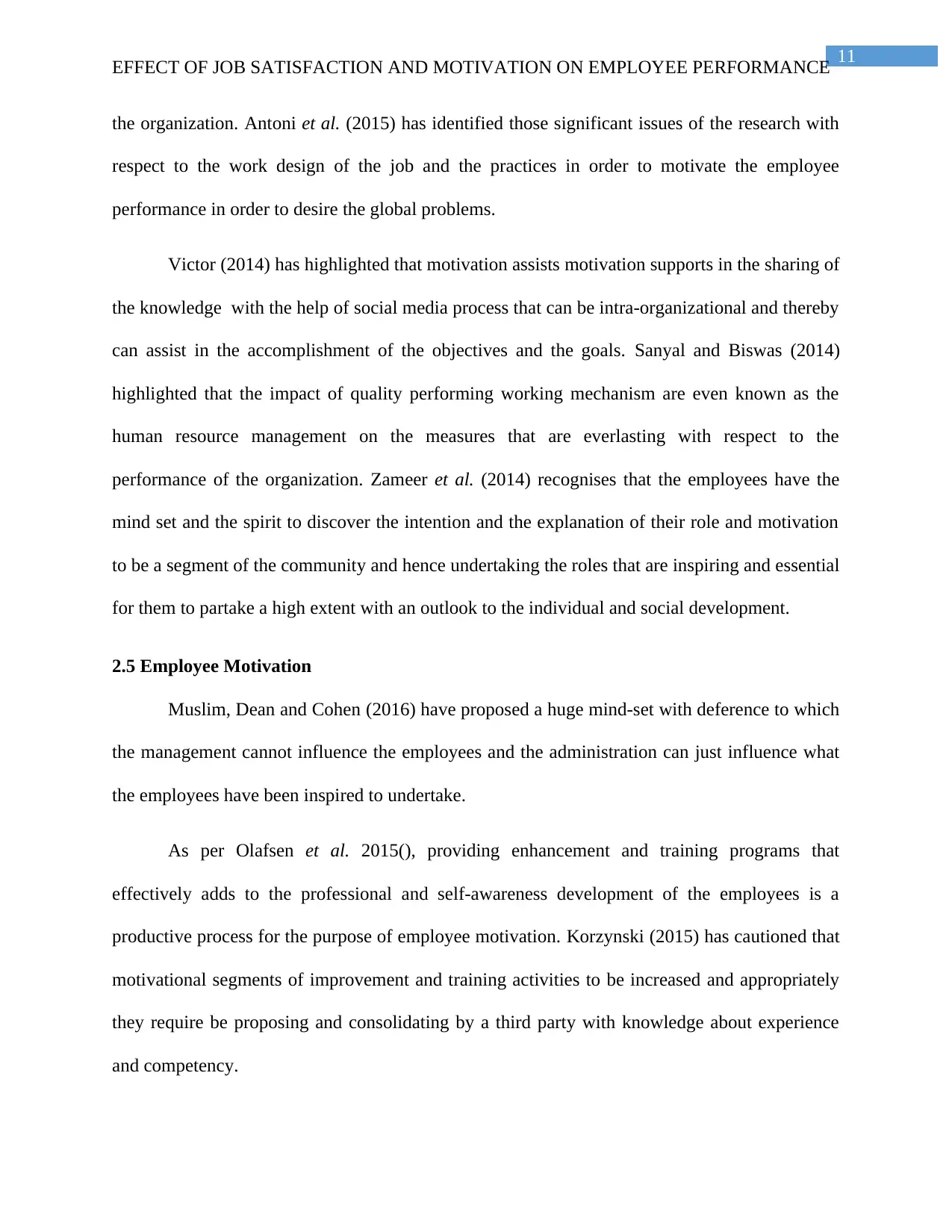
11
EFFECT OF JOB SATISFACTION AND MOTIVATION ON EMPLOYEE PERFORMANCE
the organization. Antoni et al. (2015) has identified those significant issues of the research with
respect to the work design of the job and the practices in order to motivate the employee
performance in order to desire the global problems.
Victor (2014) has highlighted that motivation assists motivation supports in the sharing of
the knowledge with the help of social media process that can be intra-organizational and thereby
can assist in the accomplishment of the objectives and the goals. Sanyal and Biswas (2014)
highlighted that the impact of quality performing working mechanism are even known as the
human resource management on the measures that are everlasting with respect to the
performance of the organization. Zameer et al. (2014) recognises that the employees have the
mind set and the spirit to discover the intention and the explanation of their role and motivation
to be a segment of the community and hence undertaking the roles that are inspiring and essential
for them to partake a high extent with an outlook to the individual and social development.
2.5 Employee Motivation
Muslim, Dean and Cohen (2016) have proposed a huge mind-set with deference to which
the management cannot influence the employees and the administration can just influence what
the employees have been inspired to undertake.
As per Olafsen et al. 2015(), providing enhancement and training programs that
effectively adds to the professional and self-awareness development of the employees is a
productive process for the purpose of employee motivation. Korzynski (2015) has cautioned that
motivational segments of improvement and training activities to be increased and appropriately
they require be proposing and consolidating by a third party with knowledge about experience
and competency.
EFFECT OF JOB SATISFACTION AND MOTIVATION ON EMPLOYEE PERFORMANCE
the organization. Antoni et al. (2015) has identified those significant issues of the research with
respect to the work design of the job and the practices in order to motivate the employee
performance in order to desire the global problems.
Victor (2014) has highlighted that motivation assists motivation supports in the sharing of
the knowledge with the help of social media process that can be intra-organizational and thereby
can assist in the accomplishment of the objectives and the goals. Sanyal and Biswas (2014)
highlighted that the impact of quality performing working mechanism are even known as the
human resource management on the measures that are everlasting with respect to the
performance of the organization. Zameer et al. (2014) recognises that the employees have the
mind set and the spirit to discover the intention and the explanation of their role and motivation
to be a segment of the community and hence undertaking the roles that are inspiring and essential
for them to partake a high extent with an outlook to the individual and social development.
2.5 Employee Motivation
Muslim, Dean and Cohen (2016) have proposed a huge mind-set with deference to which
the management cannot influence the employees and the administration can just influence what
the employees have been inspired to undertake.
As per Olafsen et al. 2015(), providing enhancement and training programs that
effectively adds to the professional and self-awareness development of the employees is a
productive process for the purpose of employee motivation. Korzynski (2015) has cautioned that
motivational segments of improvement and training activities to be increased and appropriately
they require be proposing and consolidating by a third party with knowledge about experience
and competency.
⊘ This is a preview!⊘
Do you want full access?
Subscribe today to unlock all pages.

Trusted by 1+ million students worldwide
1 out of 69
Related Documents
Your All-in-One AI-Powered Toolkit for Academic Success.
+13062052269
info@desklib.com
Available 24*7 on WhatsApp / Email
![[object Object]](/_next/static/media/star-bottom.7253800d.svg)
Unlock your academic potential
Copyright © 2020–2025 A2Z Services. All Rights Reserved. Developed and managed by ZUCOL.





